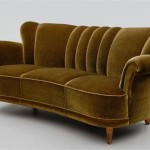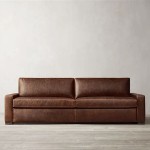Sofa or Couch: Understanding the Nuances of Seating Terminology
The terms "sofa" and "couch" are often used interchangeably to describe a piece of furniture designed for seating multiple people. While generally understood to refer to the same type of furniture, subtle historical and contextual differences can influence the choice of one term over the other. Understanding these nuances allows for more precise communication and a deeper appreciation of furniture terminology.
The evolution of seating arrangements throughout history provides context for the development of both the sofa and the couch. Early seating was primarily functional, focusing on providing a place to rest rather than comfort or aesthetic appeal. As civilizations advanced, so did the design and construction of seating, leading to the development of specialized furniture pieces designed for specific purposes and social settings.
This article will explore the etymology of "sofa" and "couch," examine their historical usage, analyze modern-day applications, and highlight the subtle distinctions that might influence the selection of one term over the other. By understanding these factors, individuals can communicate more effectively when discussing or purchasing seating furniture.
Etymological Origins: Tracing the Roots of "Sofa" and "Couch"
The word "sofa" has its roots in the Arabic word "suffah," which refers to a raised platform covered with carpets and cushions. This platform served as a traditional seating arrangement in Middle Eastern cultures. The word entered the English language in the 17th century, initially describing a similar type of upholstered seat prevalent in Ottoman and other Eastern civilizations.
The early sofas were often large and ornate, reflecting the opulence and grandeur associated with the cultures from which they originated. They were often placed against walls and served as focal points in rooms designed for relaxation and socializing. The introduction of the sofa to Europe marked a shift in seating preferences, moving away from more rigid and formal seating arrangements towards more comfortable and informal options.
In contrast, the word "couch" derives from the Old French word "couche," which in turn comes from the Latin word "collocare," meaning "to lay down." The initial meaning of "couch" referred to a piece of furniture specifically designed for lying down, similar to a daybed. This etymology highlights the original function of the couch as a place for rest and repose.
Historically, couches were often associated with medical settings or places of relaxation. Images of patients reclining on couches during consultations or individuals resting on couches in private chambers were common. The emphasis on reclining distinguishes the couch from other seating options that primarily focused on upright posture.
The diverging etymologies of "sofa" and "couch" reveal contrasting origins and intended uses. While the sofa originated as a platform for social interaction and upright seating, the couch was initially designed for reclining and individual relaxation. These historical differences, though subtle, contribute to the ongoing debate about the appropriate use of each term.
Historical Usage: Evolution of Form and Function
The historical usage of "sofa" and "couch" reflects the evolving social customs and interior design trends of different eras. In the 18th and 19th centuries, both sofas and couches underwent significant changes in design and construction, influenced by prevailing aesthetic preferences and technological advancements.
During the Victorian era, the sofa became a symbol of domestic comfort and elegance. Sofas were often heavily upholstered with rich fabrics and adorned with elaborate carvings and embellishments. They were typically placed in parlors and drawing rooms, serving as focal points for social gatherings and family interactions.
Couches, on the other hand, retained their association with relaxation and leisure. They were often smaller and less formal than sofas, and were frequently placed in bedrooms or private studies. The design of couches emphasized comfort and practicality, with features such as sloping backs and padded armrests designed for reclining.
The Industrial Revolution brought about new materials and manufacturing techniques that further transformed the design of both sofas and couches. Mass production made furniture more affordable and accessible to a wider range of consumers. This democratization of furniture ownership led to increased experimentation with different styles and designs.
In the 20th century, the lines between sofas and couches began to blur as furniture design became increasingly streamlined and functional. Modern furniture designers focused on creating pieces that were both comfortable and aesthetically pleasing, regardless of their intended use. This shift in design philosophy contributed to the interchangeable use of "sofa" and "couch" in contemporary language.
Despite the increasing overlap in usage, certain historical associations persist. Sofas are still often perceived as being more formal and structured than couches, while couches are sometimes seen as being more relaxed and informal. These perceptions can influence the choice of one term over the other in specific contexts.
Modern-Day Applications: Context and Connotation
In contemporary English, "sofa" and "couch" are largely synonymous, with both terms referring to an upholstered seat for multiple people. However, subtle differences in connotation and regional usage may still influence the choice of one term over the other in certain situations.
In some regions, "sofa" is considered to be a more formal term, while "couch" is perceived as being more casual. This distinction may be reflected in the types of furniture stores that use each term. High-end furniture retailers may prefer to use "sofa" to convey a sense of luxury and sophistication, while more budget-friendly stores may opt for "couch" to appeal to a wider range of consumers.
The specific design of the furniture may also influence the choice of term. Sectionals, which are modular seating arrangements that can be configured in various ways, are often referred to as "sectional sofas" rather than "sectional couches." Similarly, Chesterfield-style furniture, characterized by its button-tufted upholstery and rolled arms, is almost always referred to as a "Chesterfield sofa."
The intended use of the furniture can also play a role in determining the appropriate term. A piece of furniture that is primarily used for watching television or lounging may be more likely to be called a "couch," while a piece of furniture that is primarily used for entertaining guests may be more likely to be called a "sofa." This distinction reflects the historical association of couches with relaxation and sofas with social interaction.
In addition to these subtle nuances, personal preference can also influence the choice of term. Some individuals may simply prefer the sound or feel of one word over the other. Ultimately, the decision to use "sofa" or "couch" is often a matter of individual discretion.
The widespread adoption of online shopping has further blurred the lines between the two terms. Online furniture retailers often use both "sofa" and "couch" interchangeably to maximize search engine visibility and appeal to a broader audience. This practice reinforces the perception that the two terms are essentially synonymous.
While the historical and etymological differences between "sofa" and "couch" are interesting from a linguistic perspective, they are not typically relevant in everyday conversation. Most people will understand the intended meaning regardless of which term is used. However, an awareness of these subtle nuances can enhance one's understanding of furniture terminology and improve communication in specific contexts.

Faq What S The Difference Between A Sofa And Couch Wfmo

Sofa Vs Couch The Big Debate

Faq What S The Difference Between A Sofa And Couch Wfmo

Sofa Vs Couch What Is The Difference

Sofa Vs Couch Which One Is Better Love My Beds

What Is The Difference Between Sofa And Couch Ottawa Furniture Blueprint Home

What S The Difference Between Sofa Couch And Settee Swyft

Sofa Or Couch Quick And Dirty Tips

Faq What S The Difference Between A Sofa And Couch Wfmo

The Great Seating Debate Sofa Or Sectional Two Hands Interiors








